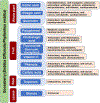Molecular Mechanisms of Cancer Prevention by Gooseberry (Phyllanthus emblica)
- PMID: 34839775
- PMCID: PMC9341453
- DOI: 10.1080/01635581.2021.2008988
Molecular Mechanisms of Cancer Prevention by Gooseberry (Phyllanthus emblica)
Abstract
Indian gooseberry (Emblica officinalis Gaertn or Phyllanthus emblica Linn; family Phyllanthaceae) has a recognized history in Indian traditional medicine (Ayurveda). Various therapeutic properties have been attributed to gooseberry as a dietary supplement. Many parts of the plant (fruits, seed, leaves, root, bark, and flowers) possess various activities and are used to treat a range of diseases. This review focuses on the evidence for the cancer-preventive properties of gooseberry, its extracts, and its principal phytochemicals based on studies In Vitro and In Vivo. Most importantly, in multiple rodent models of cancer, treatment with P. emblica was found to prevent tumor incidence, number, and volume at various organ sites. The mechanism(s) implicated in gooseberry-mediated cancer inhibition are diverse and include antioxidants, Phase I and II enzyme modifications, anti-inflammatory action, regulation of the cell cycle, and modulation of oncogenic signaling genes. Studies in humans also indicate that P. emblica can offer various health benefits and synergize with other treatments. This review provides detailed information on the potential use of gooseberry extract as an anticarcinogenic in humans, illuminates the therapeutic applications, and discusses clinical trials.
Conflict of interest statement
Disclosure statement
The authors declare no conflicts of interest.
Figures



Similar articles
-
Anticancer Properties of Phyllanthus emblica (Indian Gooseberry).Oxid Med Cell Longev. 2015;2015:950890. doi: 10.1155/2015/950890. Epub 2015 Jun 9. Oxid Med Cell Longev. 2015. PMID: 26180601 Free PMC article. Review.
-
Traditional uses, bioactive composition, pharmacology, and toxicology of Phyllanthus emblica fruits: A comprehensive review.J Ethnopharmacol. 2022 Jan 10;282:114570. doi: 10.1016/j.jep.2021.114570. Epub 2021 Sep 2. J Ethnopharmacol. 2022. PMID: 34480995 Review.
-
Amla (Emblica officinalis Gaertn), a wonder berry in the treatment and prevention of cancer.Eur J Cancer Prev. 2011 May;20(3):225-39. doi: 10.1097/CEJ.0b013e32834473f4. Eur J Cancer Prev. 2011. PMID: 21317655 Review.
-
Chemical and antioxidant evaluation of Indian gooseberry (Emblica officinalis Gaertn., syn. Phyllanthus emblica L.) supplements.Phytother Res. 2009 Sep;23(9):1309-15. doi: 10.1002/ptr.2775. Phytother Res. 2009. PMID: 19172666
-
The Phyllanthus emblica Fruits: A Review on Phytochemistry Traditional Uses, Bioactive Composition and Pharmacological Activities.Curr Top Med Chem. 2024;24(22):1917-1939. doi: 10.2174/0115680266321320240708060327. Curr Top Med Chem. 2024. PMID: 39069705 Review.
Cited by
-
Chemopreventive Potential of Phyllanthus emblica Fruit Extract against Colon and Liver Cancer Using a Dual-Organ Rat Carcinogenesis Model.Pharmaceuticals (Basel). 2024 Jun 21;17(7):818. doi: 10.3390/ph17070818. Pharmaceuticals (Basel). 2024. PMID: 39065670 Free PMC article.
-
Skin protective effect of Indian gooseberry and barley sprout complex on skin dryness, wrinkles, and melanogenesis by cell models.Nutr Res Pract. 2024 Oct;18(5):587-601. doi: 10.4162/nrp.2024.18.5.587. Epub 2024 Jun 13. Nutr Res Pract. 2024. PMID: 39398880 Free PMC article.
-
Recent Insights into the Morphological, Nutritional and Phytochemical Properties of Indian Gooseberry (Phyllanthus emblica) for the Development of Functional Foods.Plants (Basel). 2024 Feb 20;13(5):574. doi: 10.3390/plants13050574. Plants (Basel). 2024. PMID: 38475421 Free PMC article. Review.
-
Therapeutic target mapping from the genome of Kingella negevensis and biophysical inhibition assessment through PNP synthase binding with traditional medicinal compounds.Mol Divers. 2024 Apr;28(2):581-594. doi: 10.1007/s11030-023-10604-y. Epub 2023 Jan 16. Mol Divers. 2024. PMID: 36645537 Free PMC article.
-
The first high-quality chromosome-level genome assembly of Phyllanthaceae (Phyllanthus cochinchinensis) provides insights into flavonoid biosynthesis.Planta. 2022 Nov 9;256(6):109. doi: 10.1007/s00425-022-04026-7. Planta. 2022. PMID: 36350413
References
-
- Singh S, Singh A, Joshi H. Standardization of maturity indices in Indian gooseberry (Emblica afficitlalis) under semi-arid conditions of Gujarat. Indian J Agric Sci 2006;76 (10):591–5.
-
- Balasubramanian S, Ganesh D, Panchal P, Teimouri M, Narayana VS. GC-MS analysis of phytocomponents in the methanolic extract of Emblica officinalis Gaertn (Indian Gooseberry). J Chem Pharm Res 2014;6(6):843–5.
Publication types
MeSH terms
Substances
Grants and funding
LinkOut - more resources
Full Text Sources
Medical
